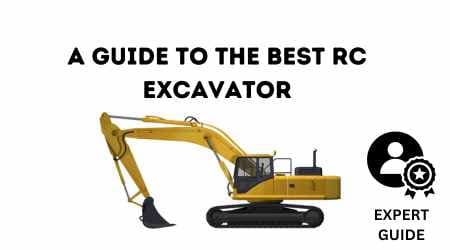
Rc excavators work through radio-controlled signals that send commands to the excavator's motors and actuators, allowing operators to direct its movements and actions. Rc excavators are a popular toy for both kids and adults that allows them to experience the excitement of controlling a heavy-duty construction machine.
These miniaturized versions of real-life excavators work through a remote control system that communicates with the excavator’s built-in motors and actuators. Remote controller transmits commands to the machine, which enable it to move, pivot, and dig. Mini excavator’s hydraulic system, motors, and gears work together to enable various movements, such as movement forward/backward, left/right turn, rotating the excavator, and raising/lowering the excavator.
In this article, we will explore how an rc excavator works in detail and what makes it so fascinating to operate.
Rc Excavator Components
Rc excavators are miniature versions of real excavators. They are made up of several components, each with its own function. Understanding the different components is crucial to operating an rc excavator effectively.
Different parts that make up an rc excavator:
- Remote control: It is the main component that controls the excavator's functions through radio signals. The remote control usually features sticks or buttons to control the movement and operation of the excavator.
- Chassis: The chassis is the framework on which all the other components are mounted. It houses the excavator's motor, battery, and driving gears. The chassis also supports the tracks or wheels of the excavator.
- Hydraulic system: It comprises several components, including hydraulic hoses, pumps, and cylinders. The hydraulic system is responsible for generating pressure, which powers the excavator arm and bucket's movements.
- Arm: The arm is the part that extends from the chassis to the bucket. It comprises three sections connected by joints. The arm's length determines the reach of the excavator, and the joints make the arm flexible for accurate digging and scooping.
- Bucket: It is a large scoop-like structure attached to the arm's end. The bucket can be maneuvered to scoop, lift, and carry objects. It features teeth-like projections that help to loosen the ground for digging.
- Tracks or wheels: Tracks or wheels are the excavator's locomotion components. The choice between tracks or wheels depends on the terrain the excavator will operate on. Tracks are better for uneven terrain, while wheels are ideal for smooth surfaces.
Functions of rc excavator components:
- Remote control sends radio signals to the excavator's receiver, which decipher the signals to drive the excavator's movement and functions.
- Chassis holds all the components of the excavator in place. It is also responsible for the excavator's locomotion power.
- Hydraulic system powers the excavator's arm and bucket's movement, which makes it possible to dig, scoop, lift and carry objects.
- Arm's joints provide flexibility to maneuver around obstacles in the excavation area.
- Bucket is used for digging, scooping, lifting, and carrying materials. Its tooth-like projections are ideal for digging through tough materials.
- Tracks or wheels provide the excavator with mobility, making it possible to navigate through uneven or smooth terrain.
How these components work together :
Rc excavator components work together to bring about precise and accurate excavating results. The remote control sends signals to the excavator's receiver, which commands the hydraulic system to lift and extend the arm to scoop materials with the bucket. The arm's joints ensure flexibility in maneuvering the excavator around obstacles in the excavation area, while the tracks or wheels provide mobility.
Overall the rc excavator components are designed in such a way that they work interdependently to ensure effective excavation results.
Read Also: A Guide To The Best Rc Excavator
Understanding The Controls
Overview Of Rc Excavator Controls
Operating an rc excavator may seem like rocket science for beginners. However, it's relatively simple once you understand the controls. In essence, the controls function similarly to those of a real excavator, but on a smaller scale. This section offers an overview of the rc excavator controls to get you familiar with the different parts before delving into their operation.
Main components of rc excavator controls are the remote controller, which houses the control levers, and the machine itself, which receives the signals sent by the controller. Remote control works via radio frequencies that enable communication between the two parts, and the levers on the controller correspond to different actions that the excavator performs.
Different Types Of Remote Controls
There are different types of remote controls for operating an rc excavator, including wired and wireless devices. The remote control you choose depends on your preferences, convenience, and, most importantly, the range of the excavator's movement.
Wireless remote controllers rely on radio waves to control the machine's movement, and they offer more freedom of movement since you don't need to stay in one spot when operating the excavator. On the other hand, wired remote controllers have wires running between the excavator and the controller, limiting the distance you can operate the machine.
When choosing a remote control, consider factors such as range, durability, responsiveness, and user-friendly controls.
Step-By-Step Guide On How To Operate The Controls
Now that you have a basic understanding of the excavator's controls, it's time to learn how to operate them. The following is a step-by-step guide on how to use the levers on the controller to control the excavator:
- Turn on the excavator's power switch and set the remote control's batteries.
- Move the left lever forward and backward to control the machine's movements back and forth.
- Move the left lever to the left or right to control the machine's rotation.
- Use the right lever to control the excavator's arm movements, i.e., up and down.
- Move the right lever to the left or right to control the excavator's bucket's rotation.
As you become more comfortable using the levers, you can move on to more advanced maneuvers, such as digging and dumping using the excavator's bucket.
Safety Precautions When Handling Rc Excavator Controls
Operating an rc excavator requires caution, especially when it comes to handling the controls. Here are some safety precautions to keep in mind when operating the rc excavator controls:
- Make sure the excavator's power switch is turned off when not in use.
- Always use high-quality batteries in the remote controller to prevent malfunctions.
- Maintain a safe distance from other individuals, pets, and objects when operating the excavator.
- Always operate the excavator on a flat, stable surface.
- Avoid operating the excavator near water or in wet conditions.
By following these safety precautions, you can minimize the risk of accidents and damage when operating the rc excavator. Remember, safety should always come first, regardless of your experience level.
Setting Up Your Rc Excavator
Before you can start playing with your rc excavator, you need to set it up properly. This involves assembling all the different parts and ensuring everything is working as it should. In this section, we’ll cover the essential steps you need to follow to get your excavator up and running.
Guide On Assembling The Rc Excavator
Assembling your rc excavator might seem daunting, but with the right instructions and a bit of patience, it’s relatively straightforward. Here's a step-by-step guide:
- Start with the tracks and attach them to the bottom of the excavator. Ensure they are securely fastened to keep the excavator stable and prevent it from wobbling.
- Next, add the arms to the body of the excavator. These will allow it to move and dig.
- Attach the bucket to the end of the arm. This should be done carefully to ensure it is securely fixed and will not come loose.
- Install the battery and the controller. Make sure they are adequately charged, and all the wires are connected correctly.
- Test the excavator's movements and ensure that everything is functioning correctly before using it.
Tips And Tricks On Building And Customizing Your Own Rc Excavator
Building and customizing your rc excavator is a fun and rewarding activity, allowing you to create a unique and personalized machine that perfectly suits your needs. Here are some tips to help you build and customize your excavator:
- Choose the right materials for your excavator. Plastic parts are light and easy to use, but metal parts offer greater durability.
- Customize the exterior of your excavator by adding stickers and painting it.
- Add led lights to make it look more realistic and visible even in low light conditions.
- Consider upgrading the battery and remote control for greater performance and range.
- Experiment with different digging tools and attachments to expand the capabilities of your excavator.
Important Factors To Consider Before Using Your Rc Excavator
Before you can start using your rc excavator, there are several essential factors you need to consider to ensure your safety and that of those around you. Here are some important factors to consider:
- Familiarize yourself with the user manual and safety guidelines before using your excavator.
- Clear the area where you plan to use the excavator and ensure there are no obstacles or people around.
- Always operate your excavator within your line of sight and never let it out of your control.
- Be mindful of the battery life, and always keep an extra one charged and ready to use.
- Always use your excavator in a safe and responsible manner and respect the people and environment around you.
By following these setup and safety guidelines, you can enjoy the thrill of operating an rc excavator while ensuring the safety of yourself and those around you.
Rc Excavator Maintenance
Proper maintenance is essential for keeping your rc excavator in good working condition. Neglecting maintenance can lead to more significant problems and even permanent damage to your equipment. In this guide, we will explain the importance of maintenance and provide a step-by-step guide on how to maintain your rc excavator.
Explanation Of The Importance Of Rc Excavator Maintenance
Regular maintenance is essential to ensure that your rc excavator operates smoothly and efficiently. The benefits of proper maintenance include:
- Increased lifespan: Regular maintenance can extend the lifespan of your rc excavator, minimizing the need for costly repairs or replacement.
- Improved performance: Maintenance ensures that your excavator is running at optimal capacity, with all parts functioning correctly.
- Reduced downtime: Proper maintenance helps prevent unexpected breakdowns and minimize downtime, ensuring that you can complete your projects on time.
- Safety: By performing regular maintenance, you can identify potential safety hazards, such as loose bolts or worn-out tracks.
Guide On How To Properly Clean And Store Your Rc Excavator
Cleaning your rc excavator after each use is important to prevent dirt and debris from accumulating, which can cause damage to vital components. Here's how to clean and store your rc excavator properly:
- Remove the batteries and unplug the power source.
- Using a soft-bristled brush, gently clean all parts of your excavator, paying particular attention to the tracks and joints.
- Wipe down all surfaces with a microfiber cloth to remove any residual dust or debris.
- Store your excavator in a clean, dry place, ensuring that it is protected from sunlight, moisture, and extreme temperatures.
Steps On How To Troubleshoot Common Problems Encountered With Rc Excavators
Despite regular maintenance, rc excavators can sometimes experience problems that require troubleshooting. Here are some steps to help you diagnose and fix common issues:
- Problem: No power or response
- Check the batteries and connections to ensure they are functioning correctly.
- Inspect the remote control to see if it's transmitting a signal.
- Make sure that the excavator's power switches are in the ‘on' position.
- Problem: Loss of power or speed
- Check the batteries to see if they are low and need charging.
- Remove any dirt or debris from the tracks and joints to ensure smooth operation.
- Inspect the motors and gearbox to ensure that they are functioning correctly.
- Problem: Overheating
- Check that the motor and battery temperatures are within the recommended range.
- Reduce the load on your excavator, as overloading can cause overheating.
- Check for any blockages or obstructions in the tracks, which can cause extra strain on the motor.
Tips On How To Prevent Damage To Your Rc Excavator
Taking preventive measures can help avoid damage to your rc excavator and minimize the need for repairs. Here are some tips to help you prevent damage:
- Avoid overloading your excavator beyond its capacity.
- Always handle your excavator with care, avoiding any sudden movements that can cause damage.
- Do not expose your excavator to extreme temperatures, direct sunlight, or moisture.
- Regularly inspect your excavator for signs of wear and tear and perform maintenance as needed.
By following these simple maintenance tips, you can keep your rc excavator running smoothly and efficiently, ensuring that it will last for years to come.
Frequently Asked Questions Of How Do Rc Excavators Work
How Do Rc Excavators Work?
Rc excavators work by using a remote control to operate the various functions of the machine, including the arm, bucket, and tracks. The remote sends signals to the receiver in the excavator that then translates them into the appropriate movements.
The excavator is powered by rechargeable batteries.
What Are The Different Types Of Rc Excavators?
There are various types of rc excavators, including hydraulic excavators, cable excavators, and dragline excavators. Hydraulic excavators are the most popular type, and they operate the same way as full-sized hydraulic excavators. Cable excavators and dragline excavators use cables to operate the bucket and arm movements.
Can Rc Excavators Dig And Lift Heavy Objects?
Yes, rc excavators can dig and lift heavy objects to a certain extent, depending on their size and the weight capacity of the attached bucket or claw. However, they are not designed to handle the weight and size of full-sized construction equipment.
How Long Does The Battery Last On An Rc Excavator?
The battery life on an rc excavator can vary, depending on the brand and size of the machine. On average, a single battery charge can last between 20-30 minutes of continuous use. The battery can then be recharged using an adapter or a charging station.
What Age Group Is Suitable For Operating An Rc Excavator?
Rc excavators are suitable for a wide range of age groups, from young children to adults. However, younger children may require adult supervision when operating the machine, as some models can be complex to use. It's essential to follow the manufacturer's recommended age guidelines.
Where Can I Buy An Rc Excavator?
Rc excavators are available for purchase online from various retailers, including amazon, ebay, and hobby stores. Prices can vary, depending on the brand and model. It's essential to research the brand and read reviews before making a purchase.
Conclusion
Finally, after understanding the working mechanism of an rc excavator, it is pretty evident that they are fascinating pieces of machinery that offer hours of fun. The accuracy and precision with which they execute their functions are indeed awe-inspiring. The fact that you can manipulate them using the means of remote control and mimic the work of an actual excavator makes them all the more exciting.
However, it is essential to understand that operating one of these machines requires training and experience. Beginners should start slow and build their experience levels gradually for safe and efficient operation. Furthermore, it is critical to keep in mind that these machines are intricate and require proper maintenance to ensure they function optimally.
Rc excavators are a wonder to behold and are a worthwhile investment for enthusiasts looking for a challenging and enjoyable hobby.





